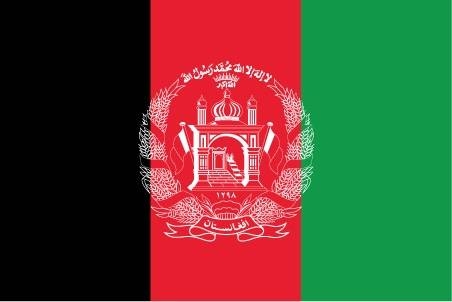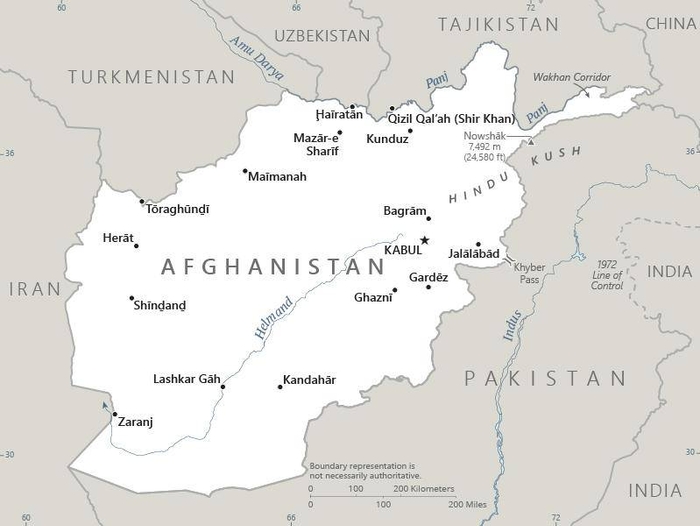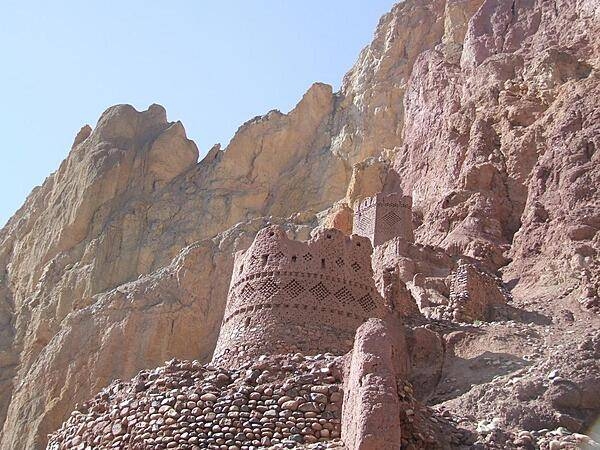126 Afghanistan

Three equal vertical bands of black (hoist side), red, and green, with the national emblem in white centered on the red band and slightly overlapping the other 2 bands. The center of the emblem features a mosque with pulpit and flags on either side, below the mosque are Eastern Arabic numerals for the solar year 1298 (1919 in the Gregorian calendar, the year of Afghan independence from the UK). This central image is circled by a border consisting of sheaves of wheat on the left and right, in the upper-center is an Arabic inscription of the Shahada (Muslim creed) below which are rays of the rising sun over the Takbir (Arabic expression meaning “God is great”), and at bottom center is a scroll bearing the name Afghanistan. Black signifies the past, red is for the blood shed for independence, and green can represent either hope for the future, agricultural prosperity, or Islam.
Flag courtesy of the CIA World Factbook

Map courtesy of the CIA World Factbook

View of Shahr-i-Zohok (the “Red City”) in Bamyan Province. The color comes from the red clay used in construction; the dry climate has allowed for the remarkable preservation.
Photo courtesy of the CIA World Factbook
Government
According to Britannica, until the mid 20th century, Afghanistan was ruled by the absolute power of the king. Two constitutions were promulgated, in 1923 and 1931, both affirming the power of the monarchy. The constitution of 1964, however, provided for a constitutional monarchy based on the separation of executive, legislative, and judicial authorities. A military coup in 1973 overthrew the monarchy, abolished the constitution of 1964, and established the Republic of Afghanistan. The Grand Assembly (Loya Jirga) adopted a new constitution in February 1977, but it was abrogated in 1978 when another coup established the Democratic Republic of Afghanistan, governed by the Afghan Revolutionary Council. Political turmoil continued, marked by a third coup in September 1979, a massive invasion of troops from the Soviet Union, and the installation of a socialist government in December 1979. Another new constitution—promulgated in 1987 and revised in 1990—changed the name of the country back to the Republic of Afghanistan, reaffirmed its nonaligned status, strengthened the post of president, and permitted other parties to participate in government. The communist regime, which had managed to hold power after the Soviet forces departed early in 1989, fell in 1992, and a coalition of victorious mujahideen parties formed a government (recognized by the UN) and named the country the Islamic State of Afghanistan. The new government was driven from the capital in 1996 by a movement based in Kandahār and calling itself the Taliban.
The Taliban leaders promptly changed the name of the country to the Islamic Emirate of Afghanistan. Espousing the supremacy of Islamic law, the Taliban did not promulgate a new constitution. In December 2001 the Taliban was toppled by a coalition of Afghan parties supported by the United States. In January 2004 a new constitution was ratified, providing for a directly elected president with two vice presidents. It also provides for a bicameral National Assembly with a directly elected lower house and an upper house comprising appointees from local and provincial councils as well as presidential appointees. The constitution establishes Islam as the state religion and prohibits laws that contradict the tenets of Islam. It also includes provisions guaranteeing gender equality and the rights of religious minorities.
Many Afghans continue to believe that “the highest manifestation of the will of the people of Afghanistan” is vested in the institution of the Loya Jirga. As a specially convened national assembly, it has traditionally held the power to amend and interpret the constitution, declare war, and adopt decisions on the most critical national issues. Loya Jirgas have played an important role in Afghan politics since the fall of the Taliban, convening in 2002 to establish a transitional government and in 2003 to ratify a new constitution. Because the Loya Jirga is closely associated with the rule of monarchy, it is revered most by those Afghans, especially in the dominant Pashtun community, who seek a more ethnically representative government than was initially installed following the Taliban’s overthrow.
Those government institutions established during the reign of ʿAbd al-Raḥmān (1880–1901) laid the groundwork for the modern Afghan state. They gave primacy to a strong military, centralized government control from Kabul, and signaled the primacy of the Pashtun as the country’s ruling group.
In practice, however, Afghan governments have never succeeded in extending their rule very deeply at the local level. This reality has meant that local influentials and power brokers would not challenge the state, and the state, in turn, would refrain from trying to interfere with them. Whatever the regime in power, a high degree of autonomy has allowed local areas to pursue economic activities and to follow tribal and localized law and customs. To administer the government’s few extractive and allocative powers, the country was divided administratively into provinces, each headed by a centrally appointed governor. The provinces were further subdivided into districts and subdistricts headed by appointed officials.
Governments have also worked through largely informal consultative bodies at the local level, such as community councils (shūrās) and tribal assemblies (jirgas), many of which have continued to function regardless of changes in national politics. In the absence of an effective central government, Afghan communities have their own social norms, but none so elaborate as Pashtun tribal law, known as Pashtunwali. With the advent of the Taliban, Islamic courts and an Islamic administration of justice through interpretation of the law by clergy (ʿulamāʾ) assumed greater prominence. These changes have widely replaced the authority once exercised by traditional local leaders, or khans.
Afghanistan has relied far more on foreign subsidies and export taxes than on internal taxes to finance its limited scope of activities. As in other rentier states, the authorities were better able to distribute resources than to collect them. It was unnecessary for national government institutions to be very effective, since there was little policy to implement. If called upon to enforce a more active government, the existing institutions were bound to invite challenge and be prone to collapse. The most far-reaching and ultimately disastrous attempt to expand the penetration of the Kabul government occurred during the early years of communist rule that began in 1978 and eventually led to civil war and chaos.
Civil / National Aviation Authority (CAA/NAA)
None found by the author.
However, should you, the reader, happen to stumble across something to the contrary, please email the author at FISHE5CA@erau.edu and you may be mentioned in the ACKNOWLEDGEMENTS section of this book by way of thanks for contributing to this free eBook!
Airspace
SkyVector – Google Maps – ADS-B Exchange
ICAO countries publish an Aeronautical Information Publication (AIP). This document is divided into three parts: General (GEN), En Route (ENR) and Aerodromes (AD). ENR 1.4 details the types of airspace classes they chose to adopt from classes A through G.
None found by the author.
However, should you, the reader, happen to stumble across something to the contrary, please email the author at FISHE5CA@erau.edu and you may be mentioned in the ACKNOWLEDGEMENTS section of this book by way of thanks for contributing to this free eBook!
Drone Regulations
None found by the author.
However, should you, the reader, happen to stumble across something to the contrary, please email the author at FISHE5CA@erau.edu and you may be mentioned in the ACKNOWLEDGEMENTS section of this book by way of thanks for contributing to this free eBook!
Advanced Air Mobility (AAM) Regulations & Policies
None found by the author.
However, should you, the reader, happen to stumble across something to the contrary, please email the author at FISHE5CA@erau.edu and you may be mentioned in the ACKNOWLEDGEMENTS section of this book by way of thanks for contributing to this free eBook!
Advanced Air Mobility (AAM) News
None found by the author.
However, should you, the reader, happen to stumble across something to the contrary, please email the author at FISHE5CA@erau.edu and you may be mentioned in the ACKNOWLEDGEMENTS section of this book by way of thanks for contributing to this free eBook!
Short Essay Questions
Scenario-Based Question
You have been hired by a Drone Startup Company. Your boss has immediately assigned this job to you.
They need you to prepare a one-page memo detailing the legalities of using a drone to film the Red City, pictured above.
They need you to mention any national laws and local ordinances.
They specifically want to know what airspace (insert pictures) you will be operating in and whether or not you need an airspace authorization.
Does it matter whether or not you are a citizen of the country?
Lastly, there is a bonus for you if, as you scroll through this chapter, you find any typos or broken links!
Short Essay Questions
- What are the drone categories?
- How is registration addressed?
- How is remote ID addressed?
- What are the model aircraft rules?
- What are the commercial drone rules?
- Are there waivers or exemptions to the rules? If so, for what?
- Would you share a link to an interactive airspace map?
- How is BVLOS addressed?
- How can you fly drones at night?
- How can you fly drones over people?
- Where do you find drone NOTAMs?
- What are the rules for drone maintenance?
- What are the rules for an SMS program?
- What are some unique rules not mentioned above?
- What are the C-UAS rules?
- What are the AAM rules?

